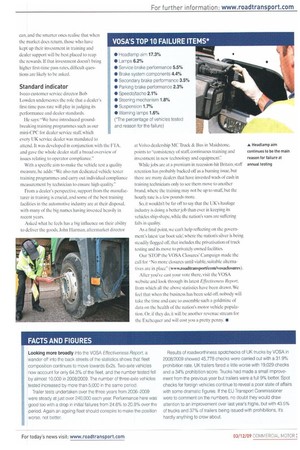FACTS AND FIGURES
Page 41

If you've noticed an error in this article please click here to report it so we can fix it.
Looking more broadly into the VOSA Effectiveness Report, a wander off into the back streets of the statistics shows that fleet composition continues to move towards 6x2s. Two-axle vehicles now account for only 64.3% of the fleet, and the number tested fell by almost 10,000 in 2008/2009. The number of three-axle vehicles tested increased by more than 5,000 in the same period.
Trailer tests undertaken over the three years from 2006-2009 were steady at just over 240,000 each year. Performance here was good too with a drop in initial failures from 24.6% to 20.9% over the period. Again an ageing fleet should conspire to make the position worse, not better. Results of roadworthiness spotchecks of UK trucks by VOSA in 2008/2009 showed 45,778 checks were carried out with a 31.9% prohibition rate. UK trailers fared a little worse with 19,029 checks and a 34% prohibition score. Trucks had made a small improvement from the previous year but trailers were a full 9% better. Spot checks for foreign vehicles continue to reveal a poor state of affairs with some dramatic figures. If the EU Transport Commissioner were to comment on the numbers, no doubt they would draw attention to an improvement over last year's highs, but with 43.5% of trucks and 37% of trailers being issued with prohibitions, it's hardly anything to crow about.














































































































































